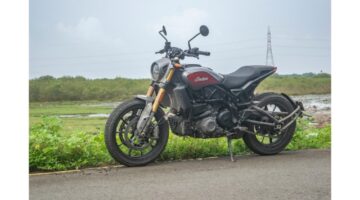Flat Track racing is one of the most popular racing formats in America. Indian Motorcycles, who also claim to be the first motorcycle manufacturers of America, have been tearing up the flat tracks with their FTR 750 flat tracker, a purpose-built championship-winning motorcycle. Indian, decided to get an FTR for the street, as the Indian FTR 1200 and here is our experience of riding it on the streets.
The Indian 1200 FTR has the looks that could kill, especially for people who love naked and raw styling. While the riding experience has been amazing, here are the ride impressions put together for this beast of a motorcycle.
It looks very raw and edgy, clearly replicates the Flat Track racing motorcycles with its aggressive-looking stance, a short tail section and Flat-Track tyres. The overall design is elegant but minimal. A bare trellis frame, fat rubber, golden shocks on both ends. LED lighting shows the way while a fully 4.3-inch digital touchscreen instrument cluster with Bluetooth connectivity makes it very modern.
The engine is a 1203cc, 60-degree V-Twin engine which is liquid-cooled. It makes 120 BHP of power and 120 Nm of torque and is mated to a 6-speed gearbox. The burble from the engine is quite muffled at low revs but throaty when revved hard and the bike feels very lively after around 5000 rpm. Drop the clutch and it very patiently crawls which helps you make it through the city traffic. The engine tends to get very hot in crawling traffic. The suspension setup comes to form SACHS, USD forks on the front and the rear is mounted with a mono-shock, both of which are fully adjustable. Braking power is courtesy of Brembo M4.32 callipers and dual discs on the front and a rear single pot calliper from Brembo shaving speeds instantly when needed.
Three rider modes viz Rain, Road and Sport can be selected via the touchscreen. In the track mode, one can choose to disable the Traction Control and ABS. Cruising on the highway was not an issue as the engine can hold high speeds upwards of 120 km/hr with ease. The safety net includes ABS, Traction Control and an IMU that aids the cornering ABS. The Pro Taper handlebars are wide enough to make you feel like sitting on a flat tracker while the short rear fender with integrated grab rails accentuates the overall appeal. The switchgear quality is very premium and the overall fit and finish of the FTR are superb.
Handling is amazing on the FTR 1200 and it is very nimble even with its 230 kgs of kerb weight. The seat height of 840mm could be a challenge for some shorter riders. The gearshifts are on point with the neutral being the easiest to find. The 12.9-litre tank under the seat actually is small for this gas guzzler that could make long-distance ride have frequent fuel stops. The slipper clutch makes the clutch-pull almost feel like a 150cc commuter.
Well, this Indian, is what not the other Indians are. It gets out of the typical Indian cruiser silhouette and makes a new identity for itself. You will end up spending Rs. 15.99 lakhs (ex-showroom) for this Flat Tracker for the street, but be wary, you will have a wide smile each and every time you ride it.
SPECIFICATIONS
- Engine: 1203cc, 60-Degree V-Twin
- Power: 120 Bhp
- Torque: 120 Nm
- Transmission: 6-Speed Gearbox
